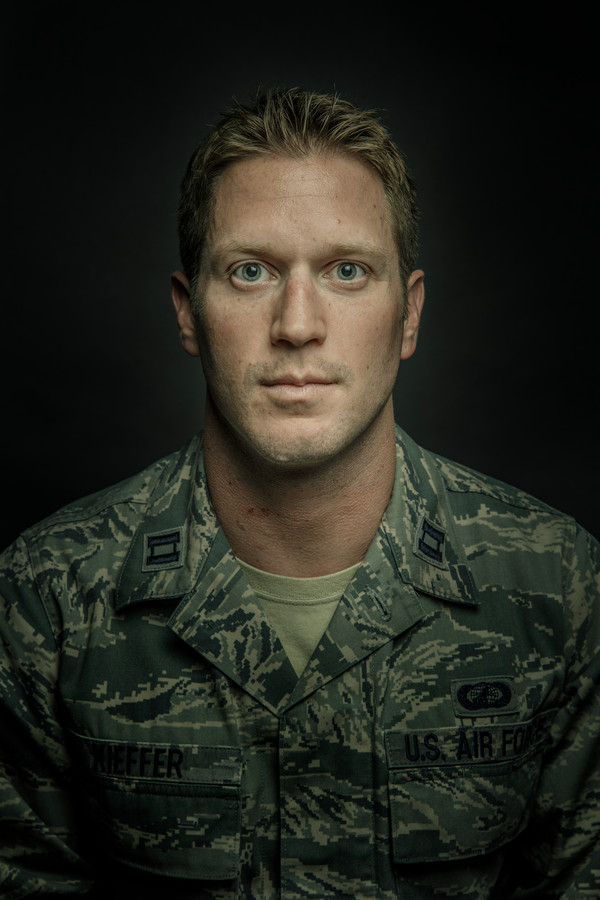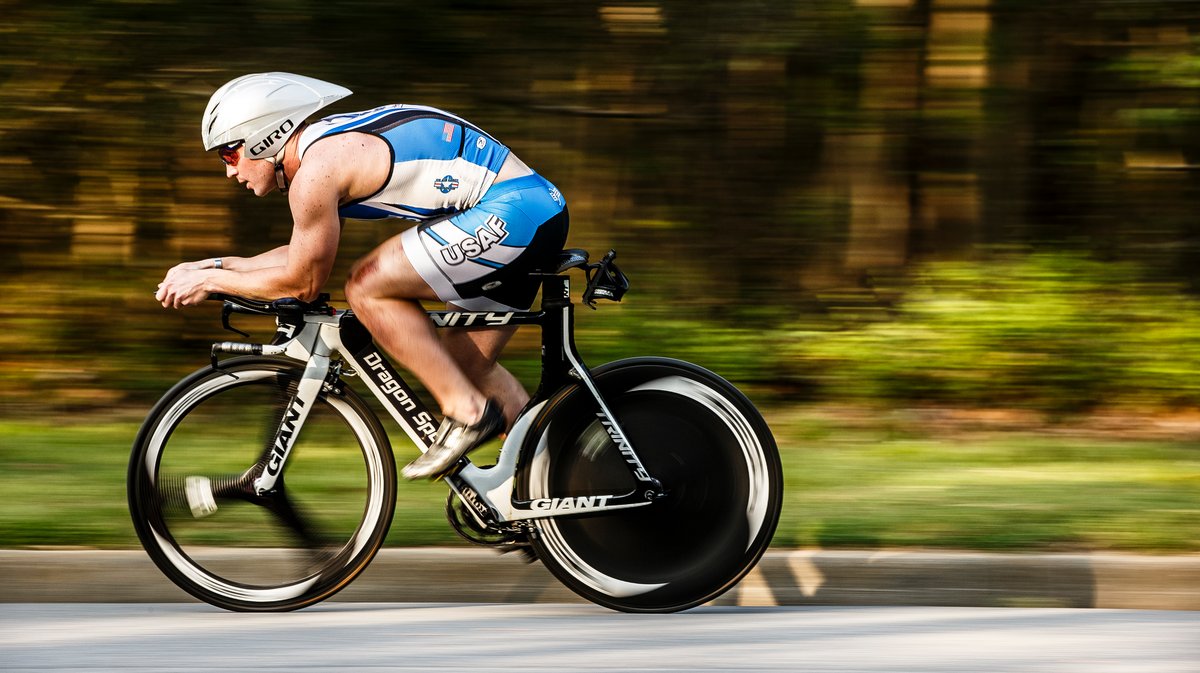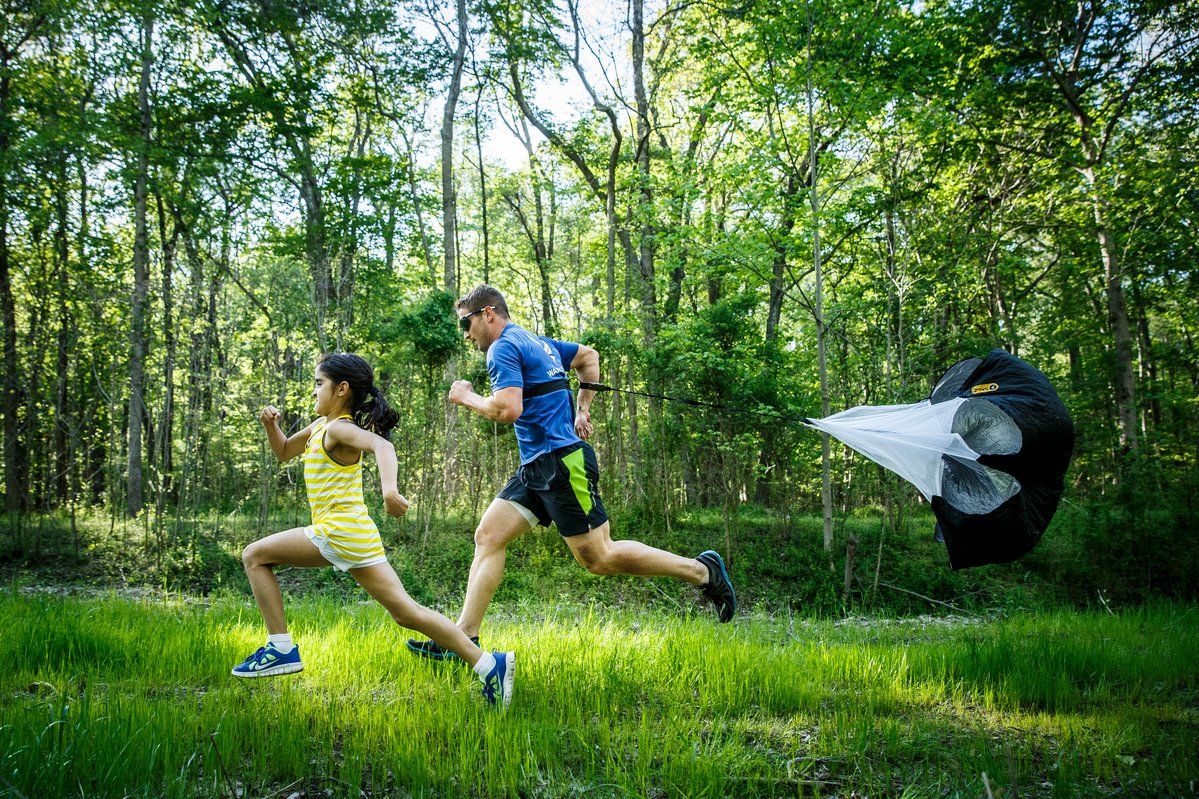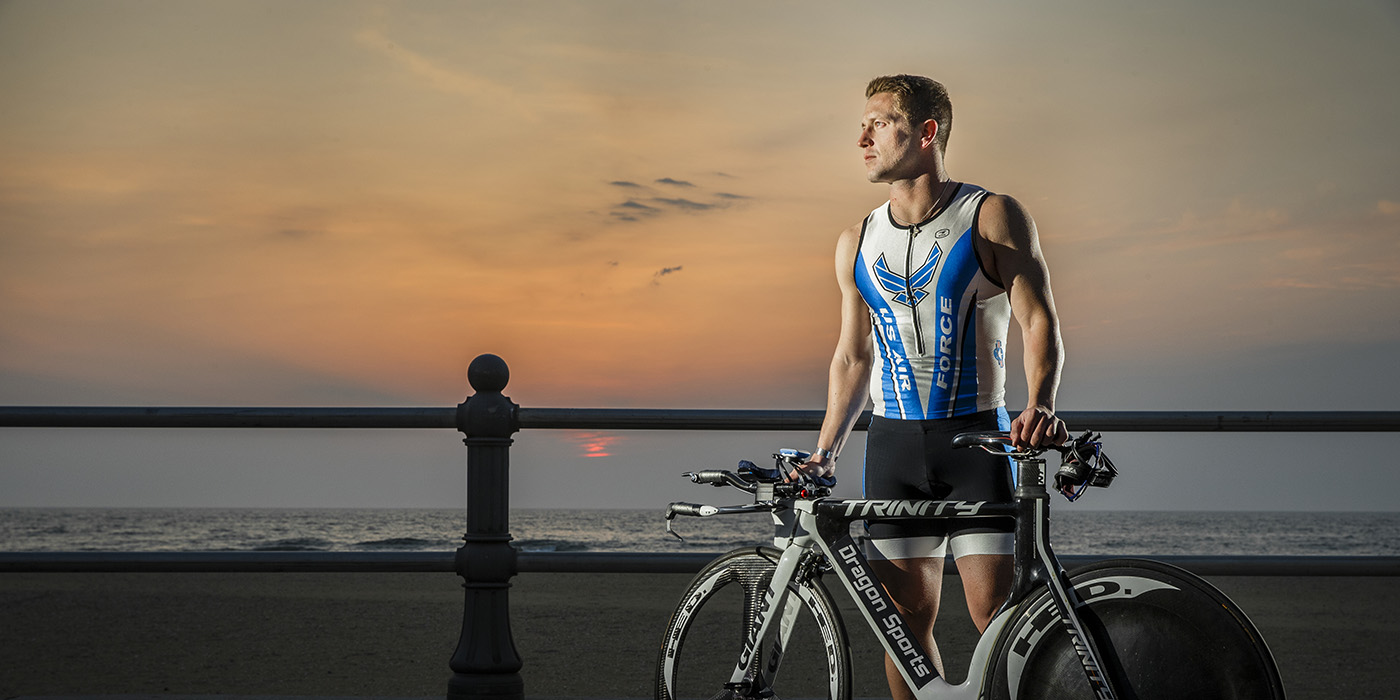On Feb. 21, 2011, U.S. Air Force Capt. Mitch Kieffer ’07 was riding in the third SUV of a four-vehicle convoy when it was ambushed on the outskirts of Baghdad Province. The explosive that ripped through his truck left him with compression fractures in his spine and a traumatic brain injury.
Now, chronic back pain and headaches are a way of life for the Purple Heart recipient. A member of the highly selective Air Force Triathlon Team from 2008 to 2010, Kieffer, 29, keeps pain and depression at bay, in large part, by pushing his physical limits as a multisport athlete.
Last May, Kieffer not only conquered his pain but also the Ultimate Champion title in the 2013 Warrior Games, hosted by the U.S. Paralympics. The highly competitive event pits 10 specially selected members of each branch of the U.S. military against each other in a pentathlon-style competition. To win the title was a remarkable achievement. Not only because the title is considered the most prestigious and competitive of the games but also because an airman hadn’t nabbed first place since the games began in 2010.
Kieffer’s road to recovery has tested his endurance, but his endurance athletics have given him the patience and perseverance to stay the course in the longest, unfinished pursuit of his life to date – a life free of pain.
‘God was on our side that day’
 Kieffer, who had overseen more than 40 similar missions without serious incident, was in the fifth month of his six-month deployment with the U.S. Army Corps of Engineers on the day that changed his life."I was an Air Force guy in an Army uniform," he told the Air Force Print News Today last year. Attached to the Baghdad Resident Office, Kieffer had volunteered to be an operations officer for the Army. His job was to plan and execute "a lot of movements to different project sites. We were there to build police stations, hospitals, telecommunications centers and tank facilities for their (Iraq’s) army."
Kieffer, who had overseen more than 40 similar missions without serious incident, was in the fifth month of his six-month deployment with the U.S. Army Corps of Engineers on the day that changed his life."I was an Air Force guy in an Army uniform," he told the Air Force Print News Today last year. Attached to the Baghdad Resident Office, Kieffer had volunteered to be an operations officer for the Army. His job was to plan and execute "a lot of movements to different project sites. We were there to build police stations, hospitals, telecommunications centers and tank facilities for their (Iraq’s) army."
En route, "We were attacked in the middle of nowhere," Kieffer remembered. "When we’d go to rural sites where there’s a higher chance of danger we’d usually take MRAPs (mine-resistant ambush-protected vehicles), but they were in the shop that day, so we were stuck in lightly armored SUVs," which are enforced with thin steel and bullet-proof glass, and can only protect against small bullets.
He and several other men − British contractors and Army personnel − were en route to a construction site when three of the four vehicles were directly hit by detonated IEDs (improvised explosive devices), RPGs (rocket propelled grenades) and small arms fire. Kieffer’s vehicle took the biggest hit. An EFP (explosively formed penetrator IED) tore through his side of the truck. It traveled two feet in front of his forehead before punching through the other side of the truck.
An EFP is a more aggressive type of IED, which emits an intense blast wave along with copper fragments in a focused direction. Kieffer’s up-close-and-personal definition is more poetic: "a lot of high-explosive bomb material behind a dinner-plate-shaped copper dish. The explosive-shaped charge turns the copper dish into a slug of big ol’ bullets that slice through armor like butter."
The force of the explosion knocked out Kieffer for a few moments. He came to, still dazed, in a haze of smoke and to the shouting of his fellow troops. The interior was "in shambles." Lights had dislodged. Wires hung from the ceiling.
The assault, however, had only just begun. "There were two IEDs that seemed to go off simultaneously. The first was a conventional IED on the first vehicle, while the second was the EFP on our vehicle. Both were direct hits to the center mass of our vehicles due to the adversary’s use of passive infrared technology. But that was just step one in their attack," Kieffer noted. "Step two was numerous RPGs (rocket-propelled grenades), and when they were done with those, 10 to 15 men with AK-47s started spraying us with bullets."
By Kieffer’s account, a mix of God and luck helped the team get out alive. Both RPGs that fired at Kieffer’s vehicle missed their target. In the aftermath the team discovered bullets embedded in the bullet-proof glass "exactly where they were sitting," Kieffer recalled. Somehow all of the men in the convoy survived. All of the SUVs were able to make it to a checkpoint about a quarter mile away − where they changed some flat tires from the incident − and drove two hours "back to friendlies" without breaking down.
‘Able-bodied’
To the naked eye, there is nothing about Kieffer’s physical appearance to suggest he is a combat-wounded veteran. With his lean and muscular 170-pound build, Kieffer powered his way to the top of the Ultimate Champion podium at the Warrior Games, held at the U.S. Olympic Training Center and the U.S. Air Force Academy in Colorado Springs, Colo.
More than 250 wounded, ill and injured service members and veterans participate in seven sports during the games (archery, cycling, shooting, sitting volleyball, swimming, track and field and wheelchair basketball). Athletes represent the Army, Marine Corps, Navy, Air Force, Special Operations and the United Kingdom.
For the Ultimate Champion title, Kieffer had to outscore nine other service men and women – two selectively chosen from each military branch as their best bets for taking home the title. The men and women competed in their respective divisions in five events: 50-meter swim, 30-kilometer cycling road race, 100-meter sprint track, 10-meter prone air rifle shooting and shot put, earning points in each discipline.
 Kieffer scored two medals during the tournament: a silver in the shooting and a bronze in the swim. He finished fourth in the men’s bicycle open event and the swim, seventh in the men’s 100-meter and eighth in the shot put. Kieffer said he was proudest of his shooting medal, as he "practiced when I could, but I picked up that air rifle gun less than 10 times." He also was the first from the Air Force to medal in shooting, placing a fraction behind first place, beating all Army, Marine and Special Forces competitors.
Kieffer scored two medals during the tournament: a silver in the shooting and a bronze in the swim. He finished fourth in the men’s bicycle open event and the swim, seventh in the men’s 100-meter and eighth in the shot put. Kieffer said he was proudest of his shooting medal, as he "practiced when I could, but I picked up that air rifle gun less than 10 times." He also was the first from the Air Force to medal in shooting, placing a fraction behind first place, beating all Army, Marine and Special Forces competitors.
He competed in the "open" division, which means he is "abled-bodied," or not missing any limbs. The others he competed against were like him, with invisible war wounds: post-traumatic stress disorder, traumatic brain injury (TBI) and cancer survivors.
"Able-bodied," however, is a relative term. Since the explosion, Kieffer has suffered from debilitating back pain and headaches. There is no "finish line" in sight. He endures.
"Every day is a battle. The monotonous visits for therapy, surgeries, specialty care and everything else I have to do while continuing to have quality of life while trying to hinder pain and cognitive issues can be exhausting," he admitted. "But I need to keep calm and patient. I’m not going to just give up on my life and dreams."
Immediately after the explosion, Kieffer knew something was wrong, which doctors at the base in Baghdad confirmed when he was the only one from the convoy to fail a preliminary TBI test. After two weeks on bed rest in Iraq, he was medevaced to a medical center in Landstuhl, Germany, where, after two more weeks, doctors determined he "couldn’t be fixed," he recalled.
He suffered mood swings. His patience dwindled. And he "felt rough cognitively," he said. "Everything was clouded because when your brain’s not working correctly and you understand it’s not, it overwhelms you. I felt like Forrest Gump for awhile. They’d be trying to joke with me and I’d sit there with a blank stare. My processing speed was extremely slow. I’d have to break down their message, think about how I felt, how I wanted to respond, then I’d have to formulate my response. It would take me a long time to answer the simplest question, like ‘How are you?’"
Just prior to sustaining his injuries, the Air Force informed Kieffer of his next assignment: get his master’s degree in operations research/applied mathematics. Initially the assignment was a source of anxiety; he worried that his stunted cognition might be permanent. His fear wasn’t unrealistic. The first months of the 18-month postgraduate program were painstaking, especially his courses in statistics, which once had been his forte. But his inner athlete wouldn’t let him off the hook. "Doing all those mental workouts (class assignments) helped train my brain how to work again. At first the assignments took me seven hours to finish, then six, then five … after a year and a half, they were taking me two hours tops, and I graduated with an A- average."
Kieffer’s now an operations research analyst for Air Combat Command. In layman’s terms, he explained, he "analyzes the best ways for the U.S. Air Force to maintain readiness to fight future wars within budget constraints. … I have to look at many different courses of action, project future needs and supply mathematical evidence for those choices."
Charting a new course
Kieffer made a big change in his life during his senior year at St. Thomas: He stopped playing for the football team so he could train for Ironman Wisconsin, a long-distance triathlon held in Madison every September. The blast of a cannon at 7 a.m. sharp sends 3,000 athletes on course to complete 2.4 miles of swimming, 112 miles of road cycling and a marathon (26.2 miles) in under 17 hours.
A self-described "sprint-power athlete" in his youth − including shot put, pole vault, basketball and football in high school − Kieffer began his training with no endurance-sport experience. "At that time I hadn’t ever swum more than 200 yards, hadn’t biked since I was 10 and the only time I had ever run over a mile was at boot camp for the Air Force," he said.
The shift was set into motion when he learned his best friend’s mother had been diagnosed with Lou Gehrig’s disease. "I was recovering from a series of football injuries at the beginning of my senior year, and things were looking good, but then my friend Brian Keeler’s mother, Anne, was struggling with her illness so I totally switched gears. I skipped my senior year, and I don’t regret it. I’d do it again any day of the week," he said. Kieffer trained 13 to 18 hours a week for seven months in honor of his friend’s mother, transforming from a 190-pound strong safety to a leaner, faster triathlete.
Swimming, biking and running suited him, and he dove into all three sports wholeheartedly. Within four years he had competed in nearly 50 triathlons, and running and cycling races, including the 2009 Tallahassee Marathon in Florida, in which he crossed off an item on every serious runner’s bucket list: a sub-three-hour finish time – 2:57:55, to be exact, a Boston Marathon qualifying time.
Unfortunately, his friend’s mother died 10 days before the Ironman race for which he had fundraised – but she would instill in him an endurance athlete’s spirit that would help him push through the (literal) pain of the dark days ahead.
Living with pain
While his cognitive faculties have shown marked improvement, managing his chronic pain requires a litany of regular treatments. "I just started getting Botox injections into the head and neck," he said. "That’s helped decrease the pain, but my sleep is still disrupted because I feel pressure like I’m hanging upside down, so I’m taking Lunesta now."
Kieffer estimates that he spends between 30 and 40 hours in hospital clinics every month. "I’ve been offered to go under the knife but with very little hope of success with a very invasive surgery and a six-month recovery. Weekly, I go under sedation and get trigger-point injections via needles. I’ve had 10 to 15 nerve ablations, which means they burn your nerve endings. They can only do that to you every six to 12 months. I’ve tried nerve blocks, acupuncture, chiropractic therapy and all kinds of physical therapy. I’ll have Botox injections to my head and back indefinitely. And my doctors are going to try an epidural block on my spinal nerves."
He soon will visit a spine surgeon in Washington, D.C., "to fish for opportunities" to move beyond pain management toward a viable cure.
In addition to the clinic visits, Kieffer devotes two hours, usually at the end of each day, to pain management at home. He uses a TENS (transcutaneous electrical nerve stimulation) unit on his back as much as possible. TENS units provide therapeutic pulses that stimulate nerves and relax muscles via electrodes that are applied to the afflicted part of the body. His wife, Ana Maria, and his daughters, Ana Paula and Ana Cristina, are also incredible sources of support, he said.
"My three girls were heaven sent. They came into my life shortly after returning from being wounded and gave my life hope.

Kieffer trains with his daughter, Ana Christina, in Virginia Beach.
I thank God every day for the love that I feel from all three of them," he added. Ana Maria tries to help any way she can.
"Mitch is one of the strongest guys I have ever met, but the pain takes him down sometimes. I give him a massage every night before bed so he can rest better," she said.
Ana Paula helps keep the mood bright while cracking jokes and having intellectually stimulating conversations, while Ana Cristina joins in with physical therapy and pain-reducing activity.
Kieffer remarked, "I don’t know where I would be without all three of my girls. They all have an angelic persona to be able to put up with me and all of my faults, trials and tribulations."
Euphoria and motion: the greatest painkillers
Kieffer’s one-word mantra, it seems, is "euphoria": a state of well-being and happiness. Paradoxically, "euphoria" implies a state of bliss, free of pain − a state Kieffer has not known since the attack. He repeatedly uses the word − the antithesis of depression, pain and misery − to describe any array of things or experiences that brings him joy or relief from pain.
His stance on cycling, his favorite sport, most compellingly captures the transcendent quality he ascribes to athletic pain: "I love the ability to put my head down and hammer, putting myself in an immense amount of pain and agony. There is something euphoric about that type of suffering, and anytime I can do that in a race, knowing I’m making someone feel that same pain, if not more, is empowering."
Kieffer also noted that now, more than ever, he buys into the philosophy that "a body in motion stays in motion," as his orthopedic spine surgeons emphasize that low-impact exercise helps to increase blood flow to compressed discs in the spine, which leads to pain relief and/or healing.
"If you’ve had chronic pain and been knocked off your peak, it’s easy to succumb to anxiety and depression. It takes away your spirit and your hope. You can get in a really bad place. … I’ve been to that place and have to fight every day to stay out of it," he said.
Three years into his injuries, doctors have told Kieffer that they only are able to manage his ailments, at least for the foreseeable future. The frustration in his voice when he speaks of his ongoing recovery is palpable. To achieve euphoria, he must stay in motion, relentlessly propelling himself into the unknown:
"I feel the euphoria of working out. But if I stop being productive then it gets much worse because the pain defines you and it owns you and you feel like you have no freedom or control over your life. When I’m training, I don’t feel the pain as badly because I’m thinking about something else. I want to get on the bike and hammer and feel the burning in my legs versus the back pain. I want to test myself to see how hard I can go."
A race without a finish
To be a competitive athlete is, by some stretch of the imagination, an act of defiance. Athletes defy the average human’s natural drive to take it easy on a daily basis, willing their bodies out of bed early to train before their minds can tell them "No." They push themselves physically and emotionally through intense discomfort and fatigue, their sights zeroed in on a goal or finish line they believe to be somewhere in the distance.
Any endurance athlete will tell you that as much as he loves to race, after all the hours of labored breathing, road rash, bloody blisters, burning muscles and chafing on parts of his body he didn’t think was possible, often the finish line is a welcome respite, the prize for his hard-fought efforts. Chronic pain has placed Kieffer on a course that lacks the promise and reward of such a finish.
But he found a silver lining in the Warrior Games. "The Warrior Games keep the athletes’ competitive drive going. When you’re dealing with chronic pain, you’re dealing with a whole lot of emotional issues, and that can hurt you more than any of the physical pain," he said. "It’s so important to have something to strive for, and the Warrior Games give you a reason to get up and compete with people who have gone through the same things, and just do something besides feel sorry for yourself."
U.S. Air Force Maj. James Bales, who competed with Kieffer on the Air Force Triathlon Team, hand-picked Kieffer to represent the Air Force in the Ultimate Champion division "because I truly believed he would win," he said.
"I have always been impressed with how Mitch is able to get the job done, and always with a smile on his face. Soon after taking the reins as head coach of the Air Force Warrior Games team, I heard of Mitch’s injury. I’ve known sports are an integral part of his life and wanted to reach out to him, not only for his athletic prowess but because of his motivational and inspirational attitude and impact his leadership would have on the other athletes," Bales added.
Spoken like a true endurance athlete (and personal trainer for the past decade), Kieffer motivates himself and his clients to "embrace pain like a lover." The hard life lessons he learns on the bike, on the pavement or in the pool spill into all areas of his life: "Those who shy away from pain and quit when it starts to hurt will find it more difficult to adapt to adversity. When a job gets tough, or a relationship gets hard, the quitting mentality, finding an easy way out, is not an option. Embracing the pain and fighting through it works counterintuitively, ultimately improving quality and purpose of life."
The next Warrior Games begin Sept. 28, 2014, and Kieffer has set his sights on defending his title.
Read more from St. Thomas magazine.


